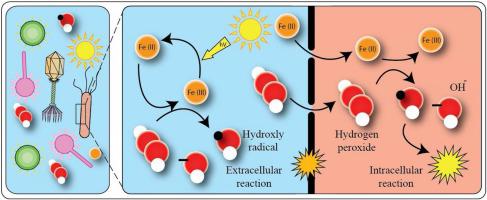Journal of Environmental Chemical Engineering ( IF 7.4 ) Pub Date : 2020-05-25 , DOI: 10.1016/j.jece.2020.104063 Kris O’Dowd , Suresh C. Pillai

|
The photo-Fenton process is an advanced oxidation process that uses the hydroxyl radical to disinfect and decontaminate water. Its non-selectivity makes it ideal for the removal of a range of microorganisms including those with antimicrobial resistance. Optimum parameters such as pH, temperature, hydrogen peroxide and iron concentrations and the intensity and wavelength of light irradiation are important to carry out an efficient photo-Fenton process. Traditionally photo-Fenton has been carried out at low acidic pH to obtain greater efficiency, but recent studies have been performed at near neutral. The current review examines the effectiveness of the photo-Fenton process at a near neutral pH for the disinfection of water. The optimal pH was seen to be at 2.8, with the efficiency of the photo-Fenton process decreasing as the pH rises. The optimal reagent concentrations showed considerable variation depending on the iron catalyst used and the iron to hydrogen peroxide concentration used. The effect of irradiance and temperature showed improved efficiency with higher levels. Different types of microorganisms such as E. coli, Pseudomonas sp., Enterococcus faecalis, Klebsiella pneumonia, Salmonella spp., total Coliforms, MRSA, MSSA, B. subtilis, Clostridium sp., Faecal Coliform, MS2 coliphage and Curvularia sp. are also examined and the effect the process will have on them. The design of reactors, such as compound parabolic reactors are also examined. The impact of light sources, including the recent reports on LEDs, on the production of hydrogen peroxide and thereby the improvement in the overall photo-Fenton disinfection is also discussed in detail. Finally, a techno-economic analysis to explain various costs associated with photo-Fenton process has also been carried out. It is concluded that the development of new heterogeneous supported immobilised catalysts that could work at the near neutral pH is an area, which requires considerable future research.
中文翻译:

接近中性pH值的光芬顿消毒:工艺,参数优化和最新进展
光芬顿法是一种先进的氧化法,它使用羟基自由基对水进行消毒和净化。它的非选择性使其非常适合去除多种微生物,包括具有抗药性的微生物。诸如pH值,温度,过氧化氢和铁的浓度以及光照射的强度和波长之类的最佳参数对于进行有效的光芬顿工艺非常重要。传统上,光芬顿已经在低酸性pH值下获得了更高的效率,但是最近的研究是在接近中性的条件下进行的。当前的审查检查了光芬顿法在接近中性pH值下对水消毒的有效性。最佳pH值为2.8,随着pH值的升高,光芬顿法的效率降低。最佳试剂浓度显示出很大的变化,具体取决于所使用的铁催化剂和所使用的铁与过氧化氢的浓度。辐照度和温度的影响显示出更高水平的改善的效率。不同类型的微生物,例如大肠杆菌,假单胞菌属,粪肠球菌,肺炎克雷伯菌,沙门氏菌属。,总大肠菌群,MRSA,MSSA,枯草芽孢杆菌,梭状芽孢杆菌,粪便大肠菌群,MS2噬菌体和弯弯曲菌sp。还检查了该过程及其对它们的影响。还检查了反应堆的设计,例如复合抛物线反应堆。还详细讨论了光源(包括有关LED的最新报道)对过氧化氢产生的影响,从而改善了整个光芬顿消毒的效果。最后,还进行了技术经济分析,以解释与光芬顿工艺有关的各种成本。结论是,可能在接近中性pH值下工作的新型多相负载型固定化催化剂的开发是一个领域,需要大量的未来研究。











































 京公网安备 11010802027423号
京公网安备 11010802027423号